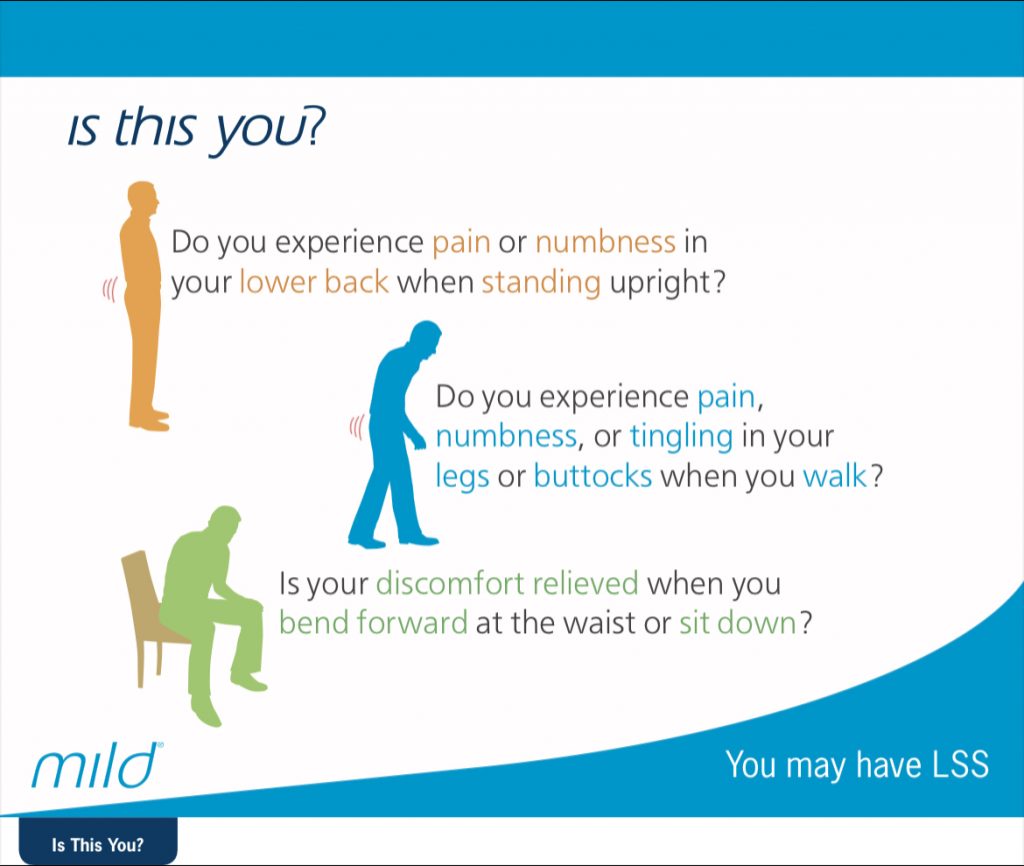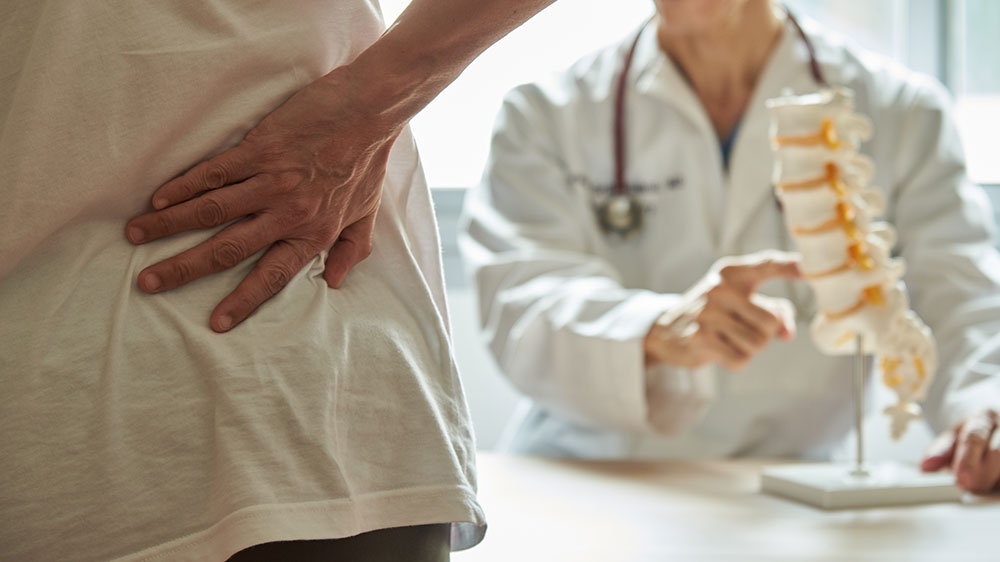A Guide to Minimally Invasive Lumbar Decompression (MILD)
Click Here to Watch a Video on the MILD Procedure
Low back pain is debilitating, so much so that 80 percent of adults experience lower back pain at some point in their lives. It is the most common type of back pain resulting in job-related disabilities and the main reason for numerous missed worked days.
Therefore, if you suffer from low back pain in the lumbar region of the spine, know that you are not alone. While this type of back pain can be caused by a variety of things, research has shown that it could be due to a popular condition known as lumbar spinal stenosis (LSS).
At Orthopaedic Center of Vero Beach, advancements in physical medicine and pain management have made it easier for our doctors to treat acute and chronic low back pain, specifically for patients suffering from LSS.
Through the means of minimally-invasive surgery and physical therapy, we will help manage each patient’s condition, to effectively relieve pain and improve their overall quality of life.
Anatomy of the Spine
Made up of 206 bones, the human body includes the spine, which is responsible for providing the main support for the rest of an individual’s anatomy, and protection for the spinal cord from damage and injury.
The spine is comprised of 33 stacked bones called vertebrae, forming the main skeletal frame called the spinal column. If you look from the side, the spine is curved and shaped like an S. These curves work like a spring or coiled slinky. They absorb shock and allow our body to maintain balance and range of motion. The three parts of the spinal column are as follows:
- Cervical (Neck): This part of the spinal column is known as the neck region. It is the home of the spinal cord, which is the most important part of the spine, as it sends messages from the brain to the rest of the body to carry out various voluntary and involuntary actions. It also is the part of the spine that allows people to be able to freely and flexibly move their neck in all directions.
- Thoracic (Mid Back): The thoracic region or middle part of the spinal column is known as the mid-upper back. It is responsible for providing stability and helps keep the body upright, in addition to protecting the heart and lungs. The thoracic spine is known as the longest and the most complex, as it runs from the base of the neck to the abdomen, and is the only part attached to the rib cage.
- Lumbar (Lower Back): The lumbar region of the spinal column refers to the lower back. The set of vertebrae that makes up the lumbar spine is between the rib cage and pelvis, and are the largest bones of the spine. The lower back helps provide support and protect the spinal cord and nerves from becoming injured. The vertebrae increase in size as they move down the spinal column to support the weight of one’s body.
A healthy spine contains strong and flexible muscles, tendons, ligaments, and nerves, which allow us to be able to stand upright, sit, bend, and turn. However, if any of these structures because compromised or affected due to strain, injury, or disease, it can result in mild to severe acute or chronic pain.
Causes and Types of Lower Back Pain
With every injury to the back or neck, the structure of the spine changes, which is why the pain we feel can be debilitating at times, resulting in hindering one’s mobility. Our ability to move is something people should not take for granted, as those who do suffer from chronic pain, some days they are not able to move at all.
Lower back pain occurs as a result of an accident or injury from lifting something heavy or a fall. Pain also often develops over time due to factors, such as aging, being overweight, or having a sedentary lifestyle. Sitting for long periods of time, especially at work without exercising can set the stage for back problems.
Men and women are equally affected by low back pain. Although pain doesn’t discriminate, there are different levels of intensity, ranging from dull to sudden and persistent aches, which can be debilitating, and leave a person incapacitated for some time.
Acute Low Back Pain
Most of the time, low back pain is acute or short-term, which means it lasts a few days or weeks at most. Acute lower back pain is caused due to a problem with the way that the components of the spine, such as the muscles, intervertebral discs, and nerves work together and move.
Treatment for acute pain usually is medication and self-care, and if necessary physical therapy and low-intensity exercises to strengthen the back muscles.
Chronic Low Back Pain
The opposite of acute pain, chronic back pain in the lumbar region of the spine is the most popular. This type of pain is persistent and lasts for up to twelve weeks or longer. Even after chronic pain has been treated, it can come back. About 20 percent or one in five individuals with acute low back pain, end up developing symptoms of chronic back pain, which last up to a year.
While acute pain tends to go away a lot quicker and easier with self-care and mild treatment methods, chronic pain is different. As this type of pain is severe and persistent, in order to get rid of it, extensive physical therapy and surgical treatment are often the most common treatment options that have the best patient outcomes.
Common Low Back Problems: Lumbar Spinal Stenosis (LSS)
The most common back problems affecting the lumbar region or lower back are due to problems with the spine’s structure and its parts that make it mechanical in nature. Normal degeneration and wear and tear of the joints, discs, and bones of the spine occur as people get older.
One of the most common causes of low back pain is a condition called lumbar spinal stenosis (LSS). LSS is a painful condition affecting the lower portion of the spine. Someone with lumbar spinal stenosis experiences chronic back pain, because their spinal column begins to narrow, putting extreme pressure on the spinal cord and the nerves, resulting in pain and numbness in the legs and lower back area.
Over time, moving and walking can become debilitating, leading to weakness in the legs and sensory loss. Low back pain is rarely related to serious underlying conditions, but when these conditions do occur, they require immediate medical attention. Other common conditions affecting the lower back include:
- Intervertebral disc degeneration
- Herniated or ruptured discs
- Sciatica
- Spondylolisthesis
- Radiculopathy
- Sprains and strains
Low Back Pain Treatment: Minimally Invasive Lumbar Decompression (MILD)
Individuals with conditions such as lumbar spinal stenosis (LSS) are candidates for a procedure called Minimally Invasive Lumbar Decompression (MILD).
Treatment for low back pain will vary, as everyone and their circumstances are different. The procedure or method used depends highly on whether the pain someone is experiencing is acute or chronic. Conventional treatments for lumbar pain range from ice and heat, strengthening exercises, physical therapy, and medications.
Those with chronic pain treatment methods will most likely be more severe. For people whose diagnostic tests show reprehensible nerve damage and indicate structural changes in the spine, Dr. Miguel Rivera at Orthopaedic Center of Vero Beach will recommend surgical intervention.


More About the MILD Procedure
For those who can barely walk or stand for more than a couple minutes without developing severe pain, their quality of life is seriously impacted by LSS. This condition is a significant cause of chronic pain and a common indication for invasive spine surgery. Until a few years ago, for those with LSS, open spine surgery was the only option.
Today, as medical procedures and technology have evolved, procedures have become less invasive. We now offer a procedure called Minimally Invasive Lumbar Decompression (MILD).
During minimally invasive lumbar decompression, the patient is put under using sedation. A one centimeter (CM) incision is made using a special sculpting tool, which goes through the bones and widens the spinal canal. Small pieces of bone and excess ligament tissue are removed through a tiny incision in an individual’s back. Contrast is injected into the spine to help the doctors see a visualization of the spine, and to guide the tools into correct positioning.
The goal of MILD is a minimally invasive spine surgery (MIS) is to stabilize the vertebral bones and joints of the spine to relieve the pressure that is being put on the spinal cord. As a result, because the spinal canal is widened during the procedure, the pain will dissipate due to the nerves not being compressed any longer.
When someone has LSS, the narrowing of their spinal canal causes nerve compression as they stand or walk. This results in low back and leg pain, which is often relieved by bending down or sitting. Although to treat condition long-term, the doctors at OCVB perform MILD to widen the spinal canal to reduce nerve compression, thus relieving persistent pain in the lower back.
Are You a Candidate for Minimally Invasive Lumbar Decompression?
According to the Cleveland Clinic, candidates for minimally invasive lumbar decompression are people who cannot undergo open spine surgery or those who don’t respond well to conservative therapies such as physical therapy and medications.
As opposed to invasive open spine surgery, minimally invasive spine surgery is safer, faster, and requires less recovery time. After the MILD procedure, patients typically recover quickly and are discharged to go home after a couple of hours. Shortly after surgery, patients are required to begin rehabilitation, such as physical therapy (PT). PT will help a patient strengthen their back muscles and regain mobility.
Call the Spine Experts of Orthopaedic Center of Vero Beach
Dr. Rivera at Orthopaedic Center of Vero Beach is an expert in treating people suffering from lumbar spinal stenosis (LSS). With advancements in pain management technology, patients who are not candidates for invasive open spine surgery, now have safer options.
Individuals with LSS who undergo minimally invasive lumbar decompression (MILD) surgery will no longer experience debilitating lower back pain and be able to live a high-quality and pain-free lifestyle that they deserve.
To learn if you may be a candidate for minimally invasive lumbar decompression, contact us today at (772) 778-2009.
References
- https://www.aans.org/en/Patients/Neurosurgical-Conditions-and-Treatments/Lumbar-Spinal-Stenosis
- https://www.aans.org/Patients/Neurosurgical-Conditions-and-Treatments/Minimally-Invasive-Spine-Surgery
- https://www.ninds.nih.gov/Disorders/Patient-Caregiver-Education/Fact-Sheets/Low-Back-Pain-Fact-Sheet
- https://consultqd.clevelandclinic.org/mild-procedure-for-lss-is-highly-successful-cost-effective/
- https://www.hopkinsmedicine.org/health/conditions-and-diseases/lumbar-spinal-stenosis
- https://www.rheumatology.org/I-Am-A/Patient-Caregiver/Diseases-Conditions/Spinal-Stenosis
- https://www.mildprocedure.com/the-mild-procedure.html





